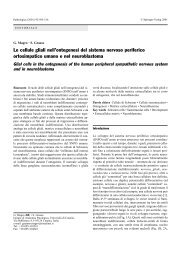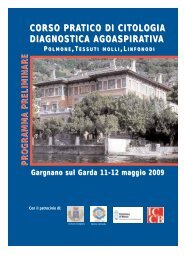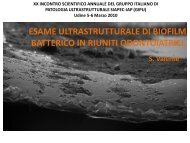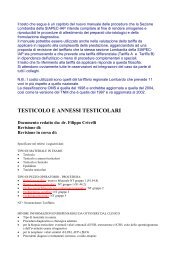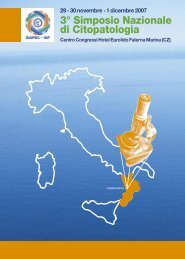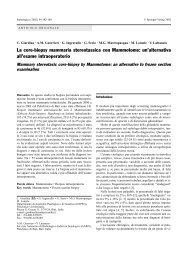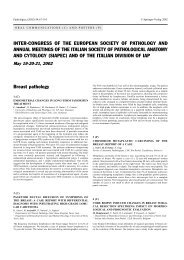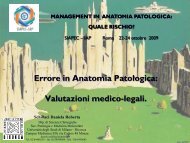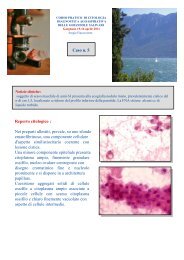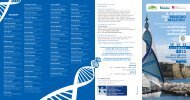328COMUNICAZIONI LIBEREw.d. 1:100), applied overnight at 4°C. The percentage ofstained cells was graded for semiquantitative purposes as follows:0 (no staining); 1 (>0 to 5%); 2 (>5 to 25%); 3 (>25 to50%); 4 (>50%). The possible correlations between immunohistochemicaldata and morphological characteristics of lesionswere investigated using non-parametric methods.ResultsMT immunoexpression was found in 54/81 cases (66.6 %)with a variable staining score. In particular 19/31 hepatocellularcarcinomas, 7/21 liver metastases, 9/10 ductal and ampullarpancreatic carcinomas and 2/2 gallbladder sampleswere stained. Moreover, 8/8 focal nodular hyperplastic ordysplastic lesions and 9/9 viral-related cirrhosis showed aconstant staining score ranging from 3 to 4. No correlationsbetween MT expression and age, sex, tumour size and clinicalstage were appreciable. The highest MT score was foundin liver control tissue; a weakly immunopositivity was encounteredin acinar cells and pancreatic ducts. No immunostainingwas appreciable in normal gallbladder.ConclusionsAn overexpression of MT has been documented in pancreaticand gallbladder neoplastic samples, while in primary andsecondary liver tumours the content of MT appears to be reducedin comparison to normal parenchyma. We cannot excludethat during carcinogenesis of different organs other MTisoforms may appear, undetectable by our antibody. Moreover,the relationship between MT immunoexpression and responsivenessto chemotherapeutics is at the moment underinvestigation.Molecular Alterations in HepatocellularCarcinomas and Preneoplastic HepatocellularLesions using Tissue Microarray TechniqueL. Tornillo 1 , A. Lugli 1 , V. Carafa 1 , M. Roncalli 2 , M. Maggioni3 , A. Manca 4 , G. Massarelli 4 , S. Losito 5 , G. Marino 6 ,R. Vecchione 7 , L. Terracciano 1,71Institutes of Pathology, University of Basel, Schweiz; 2 HumanitasClinical Institute and San Paolo Hospital 3 , Universityof Milan, University of Sassari 4 , National Cancer Center“Pascale” 5 , Naples, Hospital “Cardarelli” 6 , Naples, University“Federico II” 7 Naples, ItalyIntroductionLiver cancerogenesis is a multistep process, but there is noclear boundary between premalignant and malignant lesions.At least three regulatory pathways (RB-1, p53 and Wnt/βcatenin)are involved in hepatocarcinogenesis.AimsMorphological and molecular features of hepatocarcinogenesisare far from being fully elucidated. We have applied thetissue microarray (TMA) technique to investigate the role ofseveral genes expression in hepatocarcinogenesis.MethodsTissues from 280 patients (443 nodules) included 233 HCCs,15 High grade (HG)-DN, 7 Low-grade(LG)-DN, 10 Large regenerativenodules, 8 small cell dysplasias, 11 large cell dysplasias,8 FNHs, 2 adenomas, 13 clonal lesions 119 cirrhosisand 17 normal livers. One sample each was placed in ourTMA. Immunohistochemical analysis included CK7, CK8,CK18, CK19, CK20, CD34, p53, CyclinD1, Cyclin D3, p16,p21, p27, Ki-67, E-cadherin, β-catenin. A FISH analysis forCyclinD1 and c-myc was further performed.ResultsImmunohistochemistry: the number of evaluable punchesranged from 267 (71%) to 317 (85%). E-cadherin and β-catenin were expressed simultaneously (p=0.0009). β-cateninmembrane expression was related to the lesion (90% inHCCs, 53% in cirrhosis, 28% in HG-DN, p
PATOLOGIA DELL’APPARATO DIGERENTE329teratura, supporterebbero l’ipotesi che la CCEF origini dall’epiteliorespiratorio del foregut, senza evidente partecipazionedella “componente intestinale”.Bibliografia1Chatelain D, Chailley-Heu B. The ciliated hepatic foregut cyst, uninusual bronchiolar foregut malformation. Hum Pathol 2000;31:241-6.Epatite da brucella: descrizione di un casopediatricoL. Reggiani Bonetti, G. Rossi, R. Valli, P. Sighinolfi, E.Tagliavini, L. Viola * , A. Bagni, L. LosiSezione di Anatomia Patologica, Università di Modena eReggio Emilia; * Dipartimento di Pediatria, Università diModena e Reggio Emilia, ModenaIntroduzioneLa Brucellosi è una antropozoonosi causata da alcuni ceppidi Brucella (B. melitensis, B. abortus e B. suis). La trasmissioneavviene per inalazione, per ingestione di alimenti derivatida animali infetti e per via transcutanea. Riportiamo uncaso di epatite da Brucella in una bambina di otto anni residentein Puglia.MetodoBambina di otto anni di origine pugliese trasferita presso ilReparto di Pediatria del Policlinico di Modena. Da alcunimesi la piccola lamentava astenia, inappetenza, artralgie diffusee febbricola.RisultatiGli esami di laboratorio evidenziavano: ipertransaminasemia(AST 83 IU/L, ALT 79 IU/L), anemia (Hb 10,9 g/dL), ipergammaglobulinemia,positività per autoanticorpi non organo-specifici anti-muscolo liscio (SMA) e anti-nucleo(ANA), negative le indagini sierologiche per HAV, HBV,HCV e HBV. Lieve epatosplenomegalia all’ecografia senzaalterazioni all’ecostruttura. Il quadro clinico orientava perepatite autoimmune, per conferma venne richiesta un’agobiopsiaepatica. Morfologicamente il quadro era caratterizzatoda un moderato infiltrato linfomonocitario con discretacomponente istiocitaria e focale aggregazione in microgranulomia livello degli spazi portali e abbondante presenza dielementi linfomonocitari nei sinusoidi. Il suggerimento diun’epatite batterica da indagare (es. Brucella) portò all’esecuzionedel test di Wright dal quale risultò una titolazione significativaper B. abortus e B. melitensis (1:1280). Un’accurataanamnesi accertò il consumo di formaggi freschi artigianalida parte della piccola paziente. Posta diagnosi di epatiteda Brucella si sottopose la paziente a trattamento antibiotico.ConclusioniL’epatite acuta può rappresentare l’unica manifestazione dellabrucellosi che deve essere presa in considerazione soprattuttoin soggetti provenienti da aree endemiche. Sebbene labiopsia epatica non presenti aspetti morfologici specifici puòrisultare dirimente in adeguato contesto clinico. Una revisionedella letteratura dimostra che anche US, CT e MRI oltre atest sierologici positivi sebbene non specifici possono essereutili per la conferma diagnostica 1 2 .Carcinosarcoma of the gallbladder.A case reportN. Scibetta, G. Sciancalepore, L. MarasàU.O. di Anatomia Patologica, ARNAS “Civico-Di Cristina-Ascoli”, PalermoIntroductionThe carcinosarcoma of the gallbladder is a rare malignanttumor, composed by two components: an epithelial, adenocarcimatousone, and a mesenchymal, sarcomatous one,with a variable expression of heterologous components,and without epithelial markers in sarcomatous share. Thistumor arises in about 67 years old females, and it is oftenconnected with lithiasis. We report a case of carcinosarcomaof the gallbladder arisen in a 79 years old female. Ultrasonographicindagations, abdomen TAC with MDC, endoscopicretrograde cholangio-pancreatography (ERCP)showed a large cholecistic mass, with hepatic involving.The patient has been subjected to cholecystectomy, withsegmental hepatic resection, common biliary duct excisionand perivisceral lymphadenectomy. Five months after thesurgery, the patient did not show any local recurrence ormetastasis.Materials and methodsThe specimens sent were formalin 4% fixed and paraplastplus included. Sections of 3 µm thickness have been preparedfor typical stains, whereas other sections have beenset on slides, previously treated with poli-l-lysin for theimmunohistochemical stains.ResultsMacroscopically fundus and corpus of the gallbladder weretaken by a vegetating neoformation, which revealed fullyinfiltrating gallbladder’ s parietis. Microscopically itwas composed by a mixture of well and poorly differentiatedtubular adenocarcinoma, positive for CEA, CK 7 andCK 20, and of sarcomatous tissue, represented by anaplasticsplindle-shaped cells, arranged in large bundles, positivefor vimentin, negative for CK 7, CK 20, EMA andCEA. Heterologous elements have not been observed, buta small share of sarcomatous cells showed a differentiationtoward smooth muscular cells, proved by the positivity forα SMA and desmin.ConclusionsThe histogenesis of this carcinosarcoma is dubious. SomeAuthors assume that the sarcomatous component representsa “dedifferentiated carcinoma cells”, because it couldderive by dedifferentiation of some adenocarcinomatousareas, for accumulation of genetic errors, during the tumoralprogression. Such theory was supported by advancedstage in the moment of diagnosis, both in our case and inevery casuistics.Bibliografia1Sisteron O, et al. Clin Imaging 2002;26:414-17.2Sadia Perez D, et al. Rev Clin Esp 2001;201:322-6.





